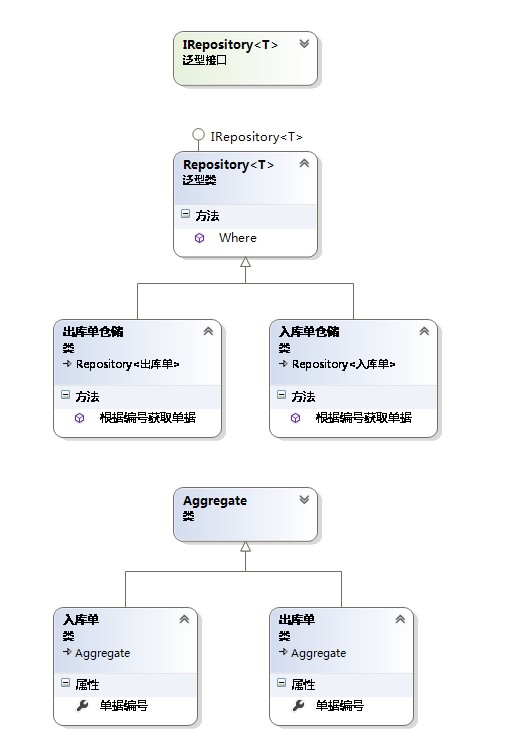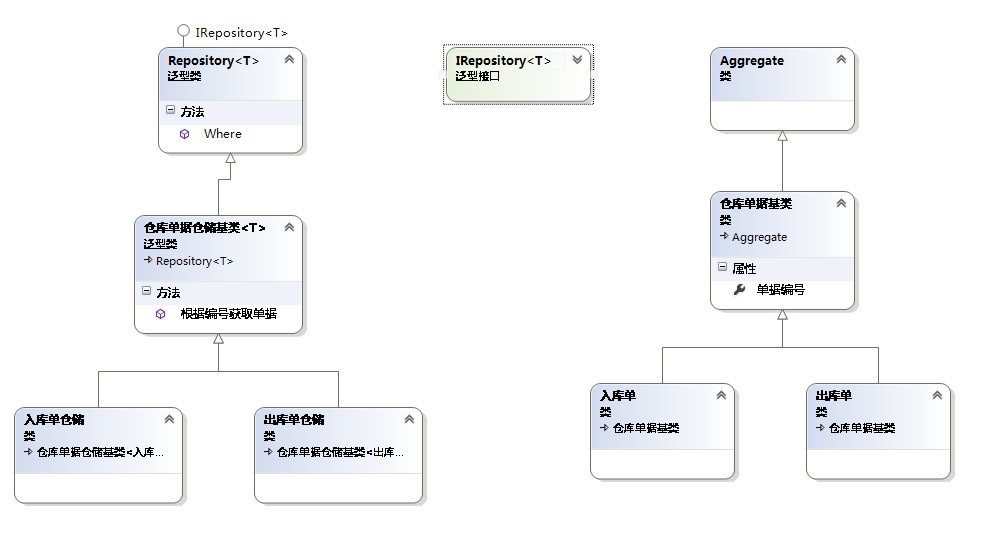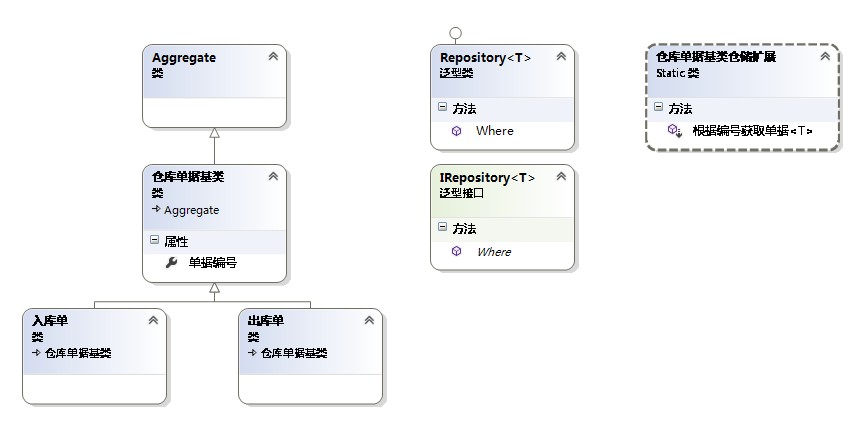目录
背景设计的演化待重构的代码用继承消除重复用扩展类(Mixin)消除重复Ruby的鸭子类型 + Mixin的实现备注
背景返回目录
今天上午和以为朋友聊了一个设计问题:如何消除仓库相关的单据的Repository中的重复逻辑?如:入库单Repository和出库单Repository之间的重复。可以有很多方式消除重复,在不同级别消除重复,如:继承、组合、掺入、帮助类、帮助方法。本文只说出我的观点:不要为了复用而使用继承。
设计的演化返回目录
下面我会演示:待重构的重复代码-》用继承消除重复-》用扩展类(Mixin)消除重复-》Ruby的鸭子类型 + Mixin的实现(元编程可以更牛叉,有机会再说)。
待重构的代码返回目录
注意:出库单仓储和入库单仓储的“根据编号获取单据”重复了。
类图

代码
1 using System; 2 using System.Collections.Generic; 3 using System.Linq; 4 using System.Text; 5 using System.Threading.Tasks; 6 using System.Linq.Expressions; 7 8 namespace CSharpStudy.MixinStudy.V1 9 { 10 class Aggregate { } 11 12 interface IRepository<T> where T : Aggregate 13 { 14 IEnumerable<T> Where(Expression<Func<T, bool>> condition); 15 } 16 17 class Repository<T> : IRepository<T> 18 where T : Aggregate 19 { 20 public IEnumerable<T> Where(Expression<Func<T, bool>> condition) 21 { 22 throw new NotImplementedException(); 23 } 24 } 25 26 class 入库单 : Aggregate 27 { 28 public string 单据编号 { get; set; } 29 } 30 31 class 出库单 : Aggregate 32 {
用继承消除重复返回目录
当我看到上面的重复代码的时候,第一印象是引入两个基类:仓库单据基类和仓库单据仓储基类。
类图

代码
1 using System; 2 using System.Collections.Generic; 3 using System.Linq; 4 using System.Text; 5 using System.Threading.Tasks; 6 using System.Linq.Expressions; 7 8 namespace CSharpStudy.MixinStudy.V2 9 { 10 class Aggregate { } 11 12 interface IRepository<T> where T : Aggregate 13 { 14 IEnumerable<T> Where(Expression<Func<T, bool>> condition); 15 } 16 17 class Repository<T> : IRepository<T> 18 where T : Aggregate 19 { 20 public IEnumerable<T> Where(Expression<Func<T, bool>> condition) 21 { 22 throw new NotImplementedException(); 23 } 24 } 25 26 class 仓库单据基类 : Aggregate 27 { 28 public string 单据编号 { get; set; } 29 } 30 31 class 入库单 : 仓库单据基类 { } 32 33 class 出库单 : 仓库单据基类 { } 34 35 class 仓库单据仓储基类<T> : Repository<T> 36 where T : 仓库单据基类 37 { 38 public IEnumerable<T> 根据编号获取单据(string 单据编号) 39 { 40 return this.Where(x => x.单据编号 == 单据编号); 41 } 42 } 43 44 class 入库单仓储 : 仓库单据仓储基类<入库单> { } 45 46 class 出库单仓储 : 仓库单据仓储基类<出库单> { } 47 }
用扩展类(Mixin)消除重复返回目录
我对了吗?没有多态,只是为了复用就引入继承,是否合理呢?
类图

代码
1 using System; 2 using System.Collections.Generic; 3 using System.Linq; 4 using System.Text; 5 using System.Threading.Tasks; 6 using System.Linq.Expressions; 7 8 namespace CSharpStudy.MixinStudy.V3 9 { 10 class Aggregate { } 11 12 interface IRepository<T> where T : Aggregate 13 { 14 IEnumerable<T> Where(Expression<Func<T, bool>> condition); 15 } 16 17 class Repository<T> : IRepository<T> 18 where T : Aggregate 19 { 20 public IEnumerable<T> Where(Expression<Func<T, bool>> condition) 21 { 22 throw new NotImplementedException(); 23 } 24 } 25 26 class 仓库单据基类 : Aggregate 27 { 28 public string 单据编号 { get; set; } 29 } 30 31 class 入库单 : 仓库单据基类 { } 32 33 class 出库单 : 仓库单据基类 { } 34 35 static class 仓库单据基类仓储扩展 36 { 37 public static IEnumerable<T> 根据编号获取单据<T>(this IRepository<T> that, string 单据编号) 38 where T : 仓库单据基类 39 { 40 return that.Where(x => x.单据编号 == 单据编号); 41 } 42 } 43 }
Ruby的鸭子类型 + Mixin的实现返回目录
代码
1 # coding: utf-8 2 3 class Aggregate 4 end 5 6 class Repository 7 def Where(condition) 8 end 9 end 10 11 class C仓库单据基类 < Repository 12 attr_accessor :单据编号 13 end 14 15 class C入库单 < C仓库单据基类 16 end 17 18 class C出库单 < C仓库单据基类 19 end 20 21 module C仓库单据基类仓储扩展 22 def 根据编号获取单据(单据编号) 23 return self.Where({:单据编号 => 单据编号}) 24 end 25 end 26 27 class C入库单仓储 < Repository 28 include C仓库单据基类仓储扩展 29 end 30 31 class C出库单仓储 < Repository 32 include C仓库单据基类仓储扩展 33 end
Ruby正统的支持了Mixin,鸭子类型天生具备泛型的特点,比泛型强大,元编程更是牛叉(本文没有体现)。
备注返回目录
做一件事如果只有一个选择,就说明 有问题了,多思考几个方案,折中后考虑一个方案。
